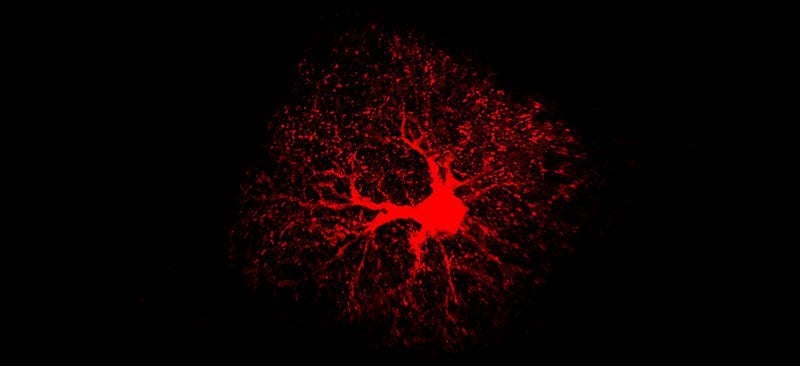Summary: Mice deficient in the NFIA gene presented astrocytes with defective shapes and altered functions in the hippocampus.
Source: Baylor College of Medicine
Researchers at Baylor College of Medicine reveal that astrocytes, the most abundant cells in the brain, play a direct role in the regulation of neuronal circuits involved in learning and memory. The findings appear in the journal Neuron.
“It has become increasingly clear that astrocytes are much more than supportive cells in the healthy adult brain. They play a direct role in a wide variety of complex and essential functions, including neuronal communication through synapses and regulation of neural circuit functions,” said corresponding author Dr. Benjamin Deneen, professor of neurosurgery and a member of the Center for Stem Cell and Regenerative Medicine at Baylor. “In this study, we show a new role of astrocytes in normal brain function.”
Previous work showed that astrocytes comprise diverse populations with unique cellular, molecular and functional properties. They occupy distinct brain regions, indicating regional specialization. There is evidence suggesting that transcription factors – proteins involved in controlling gene expression – regulate astrocyte diversity. Deneen and his colleagues looked to get a better understanding of the role transcription factor NFIA, a known regulator of astrocyte development, played in adult mouse brain functions.
The researchers worked with a mouse model they had genetically engineered to lack the NFIA gene specifically in adult astrocytes in the entire brain. They analyzed several brain regions, looking for alterations in astrocyte morphology, physiology and gene expression signatures.
“We found that NFIA-deficient astrocytes presented defective shapes and altered functions,” said Deneen, who holds the Dr. Russell J. and Marian K. Blattner Chair and is a member of the Dan L Duncan Comprehensive Cancer Center at Baylor. “Surprisingly, although the NFIA gene was eliminated in all brain regions, only the astrocytes in the hippocampus were severely altered. Other regions, such as the cortex and the brain stem, were not affected.”
Astrocytes in the hippocampus also had less calcium activity – calcium is an indicator of astrocyte function – as well as a reduced ability to detect neurotransmitters released from neurons. NFIA-deficient astrocytes also were not as closely associated with neurons as normal astrocytes.

Importantly, all these morphological and functional alterations were linked to defects in the animals’ ability to learn and remember, providing the first evidence that astrocytes are to some extent controlling the neuronal circuits that mediate learning and memory.
“Astrocytes in the brain are physically close to and communicate with neurons. Neurons release molecules that astrocytes can detect and respond to,” Deneen said. “We propose that NFIA-deficient astrocytes are not able to ‘listen’ to neurons as well as normal astrocytes, and, therefore, they cannot respond appropriately by providing the support needed for efficient memory circuit function and neuronal transmission. Consequently, the circuit is disrupted, leading to impaired learning and memory.”
Other contributors to this work include Yu-Szu Huang, Junsung Woo, Debosmita Sardar, Brittney Lozzi, Chia-Ching John Lin, Daniela Felice, all at Baylor, and Adriana Paulucci-Holthauzen at MD Anderson Cancer Center.
Funding: This work was supported by grants from the National Institutes of Health (NINDS NS071153 and NIMH AG054111) and National Multiple Sclerosis Society (RG-1501-02756). This project was also supported in part by IDDRC grant number 1U54 HD083092 from the Eunice Kennedy Shriver National Institute of Child Health & Human Development and the Cytometry and Cell Sorting Core at Baylor College of Medicine with funding from the NIH (P30 AI036211, P30 CA125123, and S10 RR024574).
About this neuroscience research article
Source:
Baylor College of Medicine
Media Contacts:
Graciela Gutierrez – Baylor College of Medicine
Image Source:
The image is credited to the Deneen lab.
Original Research:Closed access
“Region-Specific Transcriptional Control of Astrocyte Function Oversees Local Circuit Activities”. by Dr. Benjamin Deneen et al.
Neuron doi:10.1016/j.neuron.2020.03.025
Abstract
Region-Specific Transcriptional Control of Astrocyte Function Oversees Local Circuit Activities
Highlights
• NFIA is required to maintain astrocyte function in a brain-region-specific manner
• Brain-region-specific DNA binding by NFIA is inhibited by its association with NFIB
• Astrocyte-neuron communication in the hippocampus is disrupted
• Synaptic plasticity and memory are impaired in mice lacking astrocytic NFIA
Summary
Astrocytes play essential roles in brain function by supporting synaptic connectivity and associated circuits. How these roles are regulated by transcription factors is unknown. Moreover, there is emerging evidence that astrocytes exhibit regional heterogeneity, and the mechanisms controlling this diversity remain nascent. Here, we show that conditional deletion of the transcription factor nuclear factor I-A (NFIA) in astrocytes in the adult brain results in region-specific alterations in morphology and physiology that are mediated by selective DNA binding. Disruptions in astrocyte function following loss of NFIA are most pronounced in the hippocampus, manifested by impaired interactions with neurons, coupled with diminution of learning and memory behaviors. These changes in hippocampal astrocytes did not affect basal neuronal properties but specifically inhibited synaptic plasticity, which is regulated by NFIA in astrocytes through calcium-dependent mechanisms. Together, our studies reveal region-specific transcriptional dependencies for astrocytes and identify astrocytic NFIA as a key transcriptional regulator of hippocampal circuits.
Feel Free To Share This Synaptic Plasticity News.






